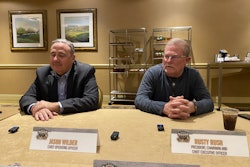There are 1001 reasons why fleet managers buy a particular part based on its price, according to Bruce Plaxton, president of BGP Marketing. He chose to focus on four of these reasons-product, vehicle age, fleet size and operational situation-as he moderated a panel comprised of top maintenance executives from four fleets.
There are two categories of parts, predictive and non-predictive. Plaxton contends that the more predictive the part, the more price sensitive the fleet is. With items like filters, coolant, oil and brake shoes, the price of the product is a major determinant for where fleets buy.
Most fleets keep their trailers for seven to nine years, and the parts-buying decisions they make when the trailer is four years old are different than the ones they make when the trailer is eight years old.
Plaxton believes that the larger the fleet the more the fleet manager understands the cost of downtime and its influence on the real cost of a product.
When describing the role price plays depending on the operational situation, Plaxton used the example of a vehicle carrying frozen pizza through the desert in August when the condenser goes out. “Is price an issue,” Plaxton asked?
If the part is a non-predictive part, availability is the key to where fleets buy. “The person with the part on the shelf will get the sale,” he said.
Plaxton next used a real world example of how situation influences a vehicle repair. He said that two vehicles from the same fleet came into a truck stop each with a failed air conditioning system. One of the vehicles was heading east, the other south. The fleet manager made two different decisions. For the truck that was heading east, it authorized a $1300 repair, for the one heading south, the manager authorized a patch so the vehicle could get to a fleet maintenance facility a few hundred miles away.
Plaxton next invited his four panelists to talk about their fleets and the factors that go into their parts purchasing decisions. Steve Duley, vice president of purchasing for Schneider National Inc., manages a fleet of 11,000 tractors, 15,500 trailers and 23,000 containers. The company operates 30 maintenance facilities staffed with 600 technicians. The fleet performs 80 percent of its own tractor and trailer maintenance. It spends $45 million on replacement parts: 64 percent for inventory and 39 percent for repair purposes. Sixty percent of its parts purchases are through OEs, 10 percent through distributors and 30 percent through other sources. About 30 percent of the parts it purchases are proprietary.
When Duley considers a parts purchase, the first thing he looks at is if the part meets the specifications Schneider has set. Service performance, price, nationwide pricing and service, and central order and billing are some of the other things he looks at.
“We seek the best overall value, not just pricing,” Duley says.
Sid Gooch, managing director of vehicle maintenance and support services for FedEx Express, manages a fleet of 83,033 vehicles including ground support vehicles and operates 673 shops with 1659 technicians. There is a corporate organization in place to optimize supply relationships but FedEx Express has the ability to buy parts too.
“We are committed to total cost reduction through supply chain management excellence,” he said.
“We look for quality parts at competitive prices for a lower cost of ownership,” Gooch says.
Carl Lyth, fleet manager, Northwest Ohio and Toledo Divisions of Pepsi Americas, is responsible for 12,082 assets and 49 technicians operating out of 16 locations.
“Cost is the key to open the door. However, quality and support are the final determining factors,” he says.
Lyth expects its parts suppliers to demonstrate to him why their part is more reliable. “We keep our equipment a long time, so aftermarket parts are a viable option for us. We can’t always go to the OE for the second half of the vehicle’s life.”
He added, “We look for longevity. We don’t want a supplier who builds itself on price and then prices itself out of the market.”
He says he is not afraid to look at innovation even though he likes time-tested parts.
Kevin Tomlinson, director of maintenance for South Shore Transportation has a fleet of 200 tractors and 450 trailers that are primarily flatbeds carrying home building supplies.
Tomlinson mostly buys OE parts. “We buy branded parts. We can’t afford to have a truck go down because of a product malfunction.”
Tomlinson is not comfortable using unproven parts. He also does not carry a large parts inventory because he can get most of what he needs within a day.
Plaxton asked panel members how they decided to buy a branded product vs. a private label product. Duley says that he checks out the quality of the price, speaks to others who have used the product and then considers price. “Quality and availability have to be there. If the part is a critical one we put a lot of effort into this process.”
Lyth says he looks at what big fleets are doing to help guide him in his purchasing choices. “I do not like to lead the parade. Being the leader, you can get hit by the bugs.”
When Gooch is considering adding a part, he first tries it in a limited number of locations and monitors its performance.







